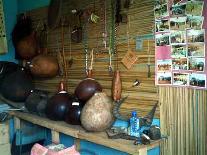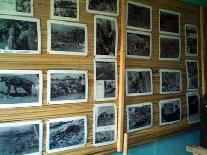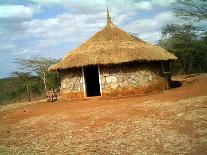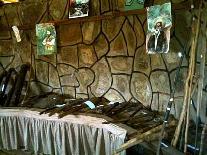AFRICA
Community Peace Museums Heritage Foundation (Kenya)
(Nov. 27, 2008)
by Timothy Gachanga, Director
In the 1990s there were a large number of conflicts in East Africa, including conflicts in the countries of Somalia, Burundi, and Rwanda. There was also conflict in Kenya among the ranching community due to cattle rustling, a problem that still persists today. Amid these circumstances, Community Peace Museums Heritage Foundation (CPMHF) began as a community development program in 1994. The Kenyan ethnographer Dr. Sultan Somjee initiated the program and it was sponsored by the Mennonite Central Committee.
Known as the Material Culture Project, a focus on the collection and documentation of artifacts was the starting point for sharing and learning about "utu" values. "Utu" is a Kiswahili word derived from "mtu," which means a human being and stands for a set of humanistic values. Utu teaches how we should live and relate to each other and the environment. We exist, but only in relationship to the community and to our environment. So when something happens to one, whether good or bad, it happens to us all. Utu thus symbolizes the deep emotions of respect, solidarity, and ties to the family, the community, and nature.
The Material Culture Project began with a series of field research activities and exhibitions of peace material culture collected during this research. Workshops followed, which were aimed at demonstrating indigenous African peace building traditions and discussing how they can be applied in situations of violence. This was at a time, during the 1990s, when “ethnic wars” and massacres ravaged Eastern Africa from the Great Lakes to Somalia. The exhibitions of peace material culture and workshop events that took place in Nairobi and several rural locations sought to make Utu visible while also creating awareness about reclaiming and sustaining a heritage of humanistic values that were being lost.
The concept of Community Museums was also explored at this time in order to bring together the material and oral sources from fieldwork, workshops, and exhibitions. The concept of community museums was appreciated because it ensured a “people grounded” approach growing from below. We thought of community museums as participatory places not only to exhibit Utu but also to involve the community in making and utilizing the space to discuss the violence that had gripped Eastern Africa. Elders participating in the workshops at the time were thinking in practical ways and they worked closely with field assistants.
The result of applying Utu to a physical space became the phenomenon of a Community Peace Museum that is not defined by borders yet contained in its parameters are collections of peace material culture in the households of ritual masters that connect to geographical peace symbols in the surrounding natural sites. Africans do not have a habit of collecting artifacts in a house for the sake of history. However, there are sacred spaces and peace trees where the community gathers to seek reconciliation, restitution, and blessings. Artifacts of peace are often carried back and forth to the sites where Utu prevails.
The diverse experiences gathered by listening to elders and observation of material culture over eight years, from 1994 to 2002, aimed at understanding how Community Peace Museums can function without borders, were finally brought together under a registered foundation known today as Community Peace Museums Heritage Foundation (CPMHF). There are ten such ethnic regional-based Community Peace Museums that are members of this foundation.
Today CPMHF is engaged in Utu building activities reclaiming a diminishing heritage of peace. All these activities are community participatory and each museum has a board of elders that advises and directs the activities.
Aembu Peace Museum
The Aembu Peace Museum is located along the slopes of Mt. Kenya at Nembule Administrative Centre, about 10 km from the town of Embu, is built as a semi- permanent traditional African hut structure. The circular roofing represents the collective responsibilities of the community while the king post at the centre represents the elder. The museum contains Aembu artifacts of peace and peace making. There are items such as thia, an iron tool that was used by elders in making community bee hives that provided the peace honey beer. There is nvuva, a container that was used to ferment and store peace honey beer that the elders sipped during reconciliation. There is also njungwa, a traditional stool used by elders during peace meetings. Muguki is a long, blunt spear that the elders held to show authority and respect during peace ceremonies and kigira is a fly whisk used during blessing rituals. Other items displayed are ngathi, a dancing skirt worn when closing a successful reconciliation talk, and kiuga, a ritual calabash used in serving food during peace ceremonies.
The Aembu Peace Museum is also involved in peace education. The curator, Stephen Njiru, has initiated peace gardens and peace clubs in three primary schools. The museum uses art for peace education. A resident artist interprets information, oral traditions, or spoken words during workshops into pictures (illustrations) that become visual aids. Ngugi the artist also paints peace trees, material culture, and elders. The artwork helps to keep a record of collective community memories while also encouraging communication in largely oral societies that the locally inspired pictures stimulate.
The Museum is also sensitizing the community on the need to conserve and protect a sacred forest in the neighborhood called Gatitu. This is where all the peace ceremonies were conducted by the forefathers. The forest is conserved in its indigenous state with peace trees such as mugumo, mukuyu, and mutathi that were used during the ceremonies. The community, like other communities along the slopes of Mt. Kenya, has a strong attachment to particular trees. These trees are considered sacred and are objects representing the community’s spirituality and belief system. The most significant tree is the fig tree, called mugumo in Kiembu, under which sacrifices were performed. The trees are respected because of their size, shape, and location. Today the community continues to gather around the fig trees for sacrifices during droughts, epidemics, and for giving thanks. Their sheer magnitude and the rich environment in their vicinity sustains rare plants and animal species. The communities create ingenious myths and stories around them, which have protected these trees from desecration and destruction.
Address: P.O. Box 66960, 00200, Nairobi, Kenya
Tel: +254-(0)720-442284
Days closed: Sunday, Holidays
Admission: Foreign visitors and researchers: US $20 (per peace museum); Free for local people.
(Originally published on November 17, 2008)
 Peace Museums of AFRICA
Peace Museums of AFRICA



